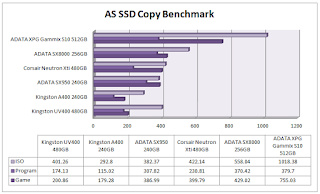ADATA XPG Gammix S10 - A game changer or just another flash in the pan!?
ADATA has become quite a household name, well a PC enthusiast house to be precise, when it comes to delivering respectable performance at really competitive price tags. Their catalogue is so rich that you can find almost all kinds of storage devices and memories on their website. Recently they unveiled their most aggressive looking SSD till date called the ADATA XPG Gammix S10 which comes with the XPG branding and hence is clearly aimed at gamers and enthusiasts alike. Keep note that this is not their fastest SSD and still resides below the top end SX8000 which is the fastest from ADATA's arsenal till date.
Thanks to ADATA India I have the Gammix S10 with me today for review and by the looks of my expectations from the product are a bit high already.
The ADATA XPG Gammix S10 series lineup comes in an M.2-2280 form-factor, uses PCIe 3.0 x4 and features 128 GB, 256 GB, 512 GB as well as 1 TB capacities and is powered by Silicon Motion’s SM2260 controller and 3D TLC NAND. The 128GB variant carries really low speeds since 3D NAND is not a great choice for low capacity drives but shines bright from the 256GB and above models which also happens to be the sweet spot of SSD storage capacities. Our ADATA XPG Gammix 512GB SSD costs around $170 or Rs 14,700 in India making it the cheapest 512GB NVMe M.2 SSD available in the market today!
What's in the Box!?
With the XPG Gammix S10 M.2 ADATA has brought back their signature XPG packing style with a black and wine red colored box having an an abstract X imprinted in the backdrop. The front clearly specifies the drive capacity, the brand logo and a big product image along with the product name at the bottom left corner.
On the back nothing much is printed except for the product name and vital details such as the various contact details to the ADATA customer care service.
This is a flip show case packaging the first of its kind from ADATA M.2 SSDs and make the product look like a decorative piece mainly due to its aggressive looks. Inside you get the SSD snug fitted inside a thick piece of foam that houses the product in a cavity for extra protection and looks. Overall the packing is apt for a product of this stature and gives it more than enough protection for bumpy transit.
A Close Look at the Gammix S10
Looking at the XPG Gammix S10 you'll notice that its small, I mean like very very small! It complies with the 2280 form factor & hence, measures at just 22mm x 80mm x 3.5mm. The first thing that we note about this SSD is the wine red heatsink that runs over the entire top length of the PCB, this also happens to be the main USP of the product and according to ADATA it can help keep the drive cooler by upto 10°C under load compared to conventional SSDs without a heatsink.
Flip the drive over and you'll find yourself a bare PCB with a warranty and serial number sticker at one end. If looked upon closely the sticker clearly states that this is not a fresh drive but a derivative or refresh of the ADATA SX7000 M.2 SSD, which doesn't have a heatsink on top, with a serial number ASX700NPC & is their entry level M.2 PCIe SSD. Also I noticed that the PCB used for the Gammix S10 is same as that of the SX8000 since all these three drives use the same controller, memory buffer and DRAM layout as per capacity.
About the heatsink its visible that there is a thermal padding running underneath the heatsink metal and the PCB components but due to the depression right in the middle of the heatsink, which is black in color and made out of premium quality plastic, the thermal padding is split into two halves on both sides leaving the center bare and in direct contact with the metal which might hamper thermal conductivity in the long run! A compromise on thermal performance for aesthetics is not the wisest of ideas which I hope ADATA would correct in their upcoming iterations of this XPG Gammix series SSDs.
The controller over here is the quad channel Silicon Motion SM2260 controller. The SM2260 is designed mainly for client and entry-level enterprise NVMe SSDs and features four 8Gbps lanes of simultaneous data flow combined with with eight NAND channels. Other supported features include Low-Density Parity Check Error Code Correction (LDPC ECC), TBW (total bytes written), Data Shaping and even RAID but has no support for AES-256 data encryption.
ADATA XPG Gammix S10 has three chips of Micron 32-layer 3D TLC NAND on both sides of the PCB with one at the bottom and two on top. These have ADATA written on top but are from Micron with model number NW825 this is due to the fact that ADATA doesn't buy Micron chips by the wafer but individually followed by their in-house binning procedures and packaging. So I'm expecting higher grade TLC NAND chips on the Gammix S10 due to the way ADATA is promoting it.
Besides, the XPG Gammix S10 drive uses a pseudo-SLC caching by dedicating one third of the 384Gbit from the Micron 3D TLC NAND chips creating a large buffer! If its been implemented effectively then we can expect high performance from this drive. A a dedicated 256 MB of DDR3 DRAM cache is also provided to compliment this installation. The module used is the Nanya NT5CC64M16GP-DI IC and is DDR3L-1600 with 11-11-11 timings.
Test Setup and Benchmarks
We used a new test bench to benchmark the ADATA XPG Gammix S10 512GB NVMe M.2 SSD -CPU: AMD Ryzen 7 1700 @3.6Ghz
Motherboard: Asus X370 Crosshair VI Hero
RAM: GALAX HOF 32GB 3600Mhz
Cooler: Stock AMD Wraith RGB Air Cooler
Graphics Card: MSI R9 380 Gaming 4G
Storage: Kingston A400 256GB
Secondary Storage: ADATA XPG Gammix S10 512GB
Power Supply: Corsair AX860i 860W
Case: Corsair Obsidian 750D
OS: Windows 10 Pro 64-bit
The drive was easy to fit in and installed without a problem. Following our usual SSD testing methods we formatted the drive and put it as a secondary drive with our main SSD loaded with Windows 10 Pro 64-bit. The entire test suite was run twice to obtain the best possible reading, each session performed after a fresh system restart. Out of the 512GB promised only 477GB on this drive is usable so around 7% of the total space is reserved for memory buffer.
TRIM Check
Since this is a very new SSD for us so it called for some new testing suits aswell, one such tool is TrimCheck which verifies if TRIM function on the drive is working perfectly or not.This shows that the TRIM function is perfectly working on the ADATA XPG Gammix S10.
Crystal Disk Info V7.0.5
Crystal Disk Info is a great tool for displaying the characteristics and health of storage devices. It displays everything from temperatures, to the number of hours the device has been powered, and even to the extent of informing you of the firmware of the device.Crystal Disk Info shows us that a bunch of useful SMART attributes are presented to the end user. Total reads and writes as well as NAND writes are shown. The firmware version we are testing with today is version CB1.1.1 with the drive working at optimum temperatures even while inside a closed case and on the Asus X370 Crosshair VI Hero which has the M.2 slot right below the PCB heatsink that happens to be quite a hot area for SSDs.
ATTO Disk
ATTO Disk Benchmark measures transfer rates across specific lengths for any storage system. ATTO uses RAW data, I set my transfer size from 0.5 to 8192kb. This is generally the most reliable benchmarks for today's SSDs.We clearly see that the ADATA XPG Gammix S10 delivers the exact read ans write speeds that the company claims also its noticeable that its performance is at par or even better than lower capacity drives and definitely way ahead of SATA SSDs for which this is aimed as a replacement.
CrystalDiskMark 5.0.2
CrystalDiskMark is a disk benchmark software that analyses different types of hard drive. Giving sequential benchmark write and read statistics in MB/s. A simple program that is very useful.Yet again we see similar results over here where the Gammix S10 is blazing ahead of the lot. Also with 34.39MB/s and 122.2MB/s of read and write speeds in the 4K segment the drive proves it point for being suitable for 4K video editing and allied works.
Anvil Storage Utility
The next test is Anvil Storage Utilities, which is a really great piece of software. The SSD benchmark gives you scores for both read and write as well as a combined score.By now its quite clear that the XPG Gammix S10 is living up to its claim and is ahead of most of the drives.
AS SSD
The AS SSD software determines the performance of Solid State Drives (SSD). The tool contains five synthetic and three practice tests. The synthetic tests determine the sequential and random read and write performance of the SSD. These tests are performed without using the operating system caches. In Sequential tests, the program measures the time it takes to read and write a 1 GB file respectively.With an overall score of nearly 1800 points the Gammix S10 surly is a great drive and we can see that it does perform very well showing loss only in a few areas which are acceptable considering it a synthetic benchmark and the real life comparison won't yield much difference.
AIDA64 Extreme Edition v5.80
AIDA64 is one of the best tools out there to check the system stability, error diagnostics and even to validate overclocking.It has a set of suites for almost every hardware out there including SSD/HDD. So we started of with AIDA64 disk suites.
As we can see that the drive is hitting the advertised speeds and is extremely consistent in read and write activities. This is a very good indications since most drives including the bigger SX8000 tends to fluctuate a lot in the Linear and Random Read tests indicating towards a more solid and consistent performance by the ADATA XPG Gammix S10.
HD Tune Pro
HD Tune Pro is one of the most popular hard drive software suites available. It has many different benchmarks and tests built into it. Our first test is the read benchmark, which tests the average read speed and access time of the drive.It was necessary to use it even after so many tests just to give all of you a graph of how constant the speed is on this SSD as many SSDs tend to fluctuate on the read/write speed which ultimately gives you unstable performance.
The results are obvious that the drive faster than the SATA drives by a large margin but is slower than the higher end SX8000. The Phison S10 controller is famous for heavy workload handling but still we some impressive results here while the drive is under milt to light workload.
PCMark Vantage
We used the PCMark Vantage HDD test which is one of the best range of test suits out there for measuring the performance of any HDD/SSD. Tests are conducted by simulating real life tasks such as Windows Start up, Gaming etc.With 118000 as the total score and minimum speed at 386.896Mb/s in the 'adding music to Windows Media Player' test the drive comes up with some very impressive stats. This is important since these are emulation of real life usage!
PCMark 8 Professional Edition
PCMark 8 Storage Test unlike PCMark Vantage scores and records the SSD performance through a set of application execution and related tasks such as Adobe Photoshop, Microsoft Office and even through games like Battlefield 3.The test ran for over an hour and we were presented with impressive scores of 5005 and all applications were executed in respectable time frames.
My Verdict
ADATA employed the IMFT's new 3D flash technology for their XPG Gammix S10 which comes with its own list of merits and demerits. The drive is very fast when it comes to raw performance and can be undoubtedly be used as a boot drive not only for desktops but also for notebooks and ultrabooks due to its universally compatible form factor. The heatsink on the new iteration of the product keeps it cool even under heavy loads erasing the blemish on the initial version that lacked a heatsink & hence ran hot at times. Infact our sample reached a maximum temperature of 45°C under heavy loads which is actually somewhat 10°C lower than what I've seen from other drives without a heatspreaders on this same motherboard and M.2 port location. The inconsistency that we observed in the SX8000 Micron TLC NAND chips has been overcome here in the Gammix S10 mainly due to the maturity that the 3D MLC NAND has reached and also due to the fact that the drive doesn't throttle due to overheating so ADATA has certainly found the perfect combination here. Being backed up by 5 years long warranty & coming in at around Rs 15,000 the drive is the cheapest 512GB NVMe M.2 SSD on the market giving it some solid brownie points especially for those who are on an ultra tight budget!
The inconsistency that we observed in the SX8000 Micron TLC NAND chips has been overcome here in the Gammix S10 mainly due to the maturity that the 3D MLC NAND has reached and also due to the fact that the drive doesn't throttle due to overheating so ADATA has certainly found the perfect combination here. Being backed up by 5 years long warranty & coming in at around Rs 15,000 the drive is the cheapest 512GB NVMe M.2 SSD on the market giving it some solid brownie points especially for those who are on an ultra tight budget!On the down side and I might be nitpicking here the XPG logo on the heatspreader is upside down once the drive in installed which is a turn off at a point since it could've been easily tackled with other than that we can't seem to find any flaws with the product.
"I highly recommend the ADATA XPG Gammix S10 512GB NVMe M.2 SSD to gamers, content producers and even system builders who are looking for an upgrade from a SATA drive and want something refreshing for their systems, offering a balance of bang on performance, pricing and eye catching aesthetics."
Pros -
- Good Performance
- Great Aesthetics
- Heatsink keeps the drive cool
- Aptly priced
- 5 years warranty
Cons -
- XPG logo is upside down























































0 comments:
Post a Comment